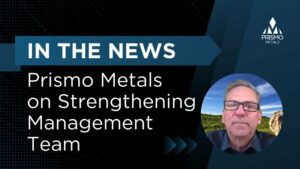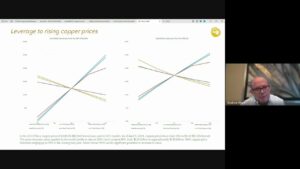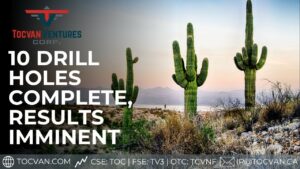Silver Bull Resources, Inc TSX:SVB announced assays from the Shallow Silver zone of its Sierra Mojada project in Coahuila State, Mexico. Results include
19.9% zinc over 10.9 metres
10.06% zinc over 1.2 metres
109.39 g/t silver over 12.6 metres
64.93 g/t silver and 1.64% zinc over 48.3 metres
27.99 g/t silver and 4.57% zinc over 15 metres
144.04 g/t silver over 31 metres
67 g/t silver and 3.41% zinc over 20.6 metres
57.8 g/t silver over 14.8 metres
30.86 g/t silver and 3.14% zinc over 57.7 metres
61.7 g/t silver and 1.83% zinc over 12.4 metres
35.66 g/t silver over 20.9 metres
77.04 g/t silver over 31.9 metres
92.5 g/t silver over 8.3 metres
89.4 g/t silver over 36.3 metres
66.54 g/t silver over 16 metres
President/CEO Tim Barry tells ResourceClips.com, �Sierra Mojada has been a historical mining district for the last 100 years. Silver Bull emerged from a merger between Metalline Mining and Dome Ventures. When Metalline had the property, they had it for over 16 years and focused almost exclusively on the zinc resource there. When the merger was done, and we got to the project, we noted there was significant at-surface silver mineralization kicking around that had never been tested. Zinc at the time was living in the 50-cent range, so we changed direction for the company and started focusing on the silver mineralization. To date, we�ve put out two resource updates. The resource right now is sitting at 47.8 million ounces indicated and 13.8 million ounces inferred, and that�s out of a global resource of 84 million ounces.
We�re going to keep drilling it out and defining the resource, to keep pushing this as fast as we can towards production�Tim Barry
�The model we�re using is similar to what Red Back Mining did, which was putting out regular resource updates every six months or so. We�ve got a very aggressive drill program underway on the property right now. There are three drills turning. The drill plan to the end of the year will probably finish up something in the order of about 50,000 metres of drilling. We have another resource update that we expect to have out 2Q of this year, which in addition to increasing the silver resource, will also, we hope, reintroduce the zinc to the story.
�We�re pleased [with these assays],� Barry continues. �What we were doing with this drill program was just testing the margins of the known mineralization. As the results show, we�ve still got some real thickness in grade. Interestingly, we�re hitting some really exciting zinc intercepts, particularly down the eastern end of the property. At the western end of the ore body, we were pleasantly surprised [to find] we had a significant increase in the grade of the mineralization as well as the thickness that we intercepted. Why we�re excited about that is because on that same trend there is a bunch of historical mine shafts that extend for another 1.5 kilometres that have never been drilled. So part of 2012 will be to focus on drilling on the western end of the known ore body.
�This year is going to be devoted entirely to continuing to expand the resource. We simply have too many near-resource drill targets that we�ve got to put some holes into. So I think we�ll start to consider a preliminary economic assessment in 2013. At the same time that the drill program is going on for 2012, we�ve also got a metallurgical program looking at both the silver and the zinc. The goal is that we�re going to keep drilling it out and defining the resource, to keep pushing this as fast as we can towards production. We�re going to keep rolling over 43-101 updates until the end of this year, thinking about PEAs and feasibilities in 2013 and where they fit into the picture.
�You�ll be able to put this into production very quickly for two reasons,� Barry relates. �One, a good portion of the mineralization sits at surface. Two, it sits at a slightly elevated position, which means you could gravity feed a lot of the ore to where you want to go. So the build-out costs, at least initially, should be pretty modest and easy to do.
�We�ve had no security issues whatsoever. Sierra Mojada actually sits at a dead-end road, which is an advantage for the simple reason that you don�t get any through traffic going into the place. The other key thing is that there is no surface water, so you don�t get any entrepreneurial horticulturalists growing anything there. We�ve had no problems at this point, and we�re probably in one of the few parts of Mexico where we haven�t had to organize a security company to come on board.
�In terms of infrastructure it couldn�t be better. We have a paved road right to the site. We�re three hours north of the city of Torreon, which is where you fly into. We have a working railway right to the site�600 metres away from where our office is. And we have high tension power lines that are 30 kilometres from the site.
Regarding how the company is funded, Barry says, �We�re in really good shape. We�ve got $12.5 million in the bank right now. It will be close to $140 million shares out fully diluted.�
Barry explains why Silver Bull is undervalued, �Number one, we�re actually in this drill program, and we actually know we�re going to hit more mineralization. We�re starting the drills off in mineralization, and there is no better drill target that you can put a drill onto. So in terms of that, [the project] is incredibly low risk. Number two, we�ve got a huge zinc resource�that we�re going to get in the next 43-101�that we get no value for in the stock whatsoever. The story between the silver and zinc are going to be quite intimately tied, because the way the ore body is set the silver actually sits over the top of where the zinc is. So you mine out the silver and finish with the zinc as the final paragraph. And simply in terms of ounces in the ground. As it stands right now, three quarters of the known silver deposit is in the indicated category. And we�re trading below peers. When you put all that together, coupled with a 50,000-metre drill program that is going ahead this year, I can see nothing but good news and good results coming forward.
�Our progress has been fantastic,� he concludes. �We had a lot of work to clean up the company when the merger happened. That is how I got involved with it. That work has been done. We�ve put together a fantastic team, led by guys with some solid proven track records, and they�ve put together a really aggressive program. We�re simply getting better and better at identifying the zones to drill and [output] from the drill rigs has been probably too fast. It�s kind of hard to keep up at times. I think 2012 will be a really exciting year.�
Contact:
Tim Barry
President/CEO
604.895.7430
by Ted Niles
























